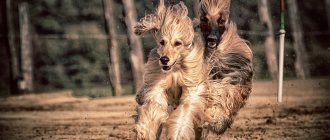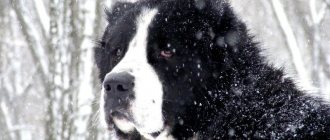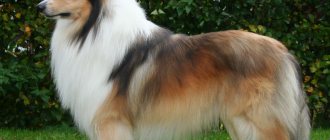What breed of dog became the main character in the American film "Beethoven"?
Beethoven's breed is St. Bernard. A real dog of this breed was involved in the filming process - white and red. The appearance in the house of the respectable Newton family with strict regulations of a puppy, who unexpectedly protected from death, and fell in love, at once, with three young children. This event turned everything upside down.
The dog tries to live according to regulations, sometimes he does harm, he loves the whole family and is ready to sacrifice his own life for their sake.
Basic moments
Saint Bernards are natives of the Swiss Alps, selfless rescuers of travelers lost in the mountains, known for their phenomenal devotion to people. Serious and collected, these white-red giants are completely devoid of arrogance and the desire to “show off” in front of their relatives. And what’s the point of proving something to someone with such impressive dimensions. Saint Bernards feel most comfortable in large, friendly families, where they are certainly not threatened by loneliness and lack of communication.
Notes
- ↑
- ↑ Beetgoven // Encyclopedic Lexicon
- Beethoven, Ludwig van // Allgemeine Deutsche Biographie
- ↑ Beethoven, Ludwig // Encyclopedic Dictionary of Brockhaus and Efron: in 86 volumes (82 volumes and 4 additional). - St. Petersburg, 1890-1907.
- H. C. Robbins Landon. Beethoven. Macmillan Company, 1970
- ↑ Eduard Herriot.
Beethoven's life (fragments from the chapter “Man, His Character”). - ↑ Velikovich E.I.
Great musical names // Composer: A manual for musicians. schools and gymnasiums. - St. Petersburg, April 3, 2006. - No. 030560. - Milton Cross, David Ewen. The Milton Cross New Encyclopedia of the Great Composers and Their Music. Doubleday, 1953. p. 79
- Glenn Stanley.
The Cambridge Companion to Beethoven. - Cambridge University Press, 2000. - ISBN 0521589347. - Henry E.
Notes from a publicist. M.: 1988. P. 94 - Henry E.
Notes from a publicist. M.: 1988. P. 93 - Susan Aldridge. Archaeforensics. What Killed...? BBC Focus, February 2008. P. 42
History of the Saint Bernard breed
The history of the formation of the breed goes back so far that experts can only speculate as to who actually was the ancestor of rescue dogs. Most modern researchers are inclined to believe that the ancestors of today's St. Bernards were Tibetan Great Danes - massively built dogs that settled throughout Central and Asia Minor in the 4th century BC. e. The animals came to Europe with the convoys of Alexander the Great, who brought them as war trophies, first to Greece, and then to Ancient Rome. However, some scientists continue to consider St. Bernards to be the “product” of mating a Great Dane with a Mastiff.
As for the name of the breed, the animals owe it to the Catholic saint Bernard of Menton, who founded a kind of shelter for travelers and pilgrims in the Swiss Alps. The establishment was located on the Great St. Bernard Pass, known for its extreme weather conditions and steep descents. Due to constant avalanches and crumbling mountain slopes, the trip to Bernard's shelter was a real game of survival. As a result, the monks of the local monastery often had to arm themselves with shovels and, instead of prayers and night vigils, go in search of tourists freezing under snowdrifts.
In the 17th century, the first St. Bernards began to be involved in rescue operations, which were bred directly at the monastery. The animals had thick skins, withstood the cold and had an excellent sense of smell, allowing them not only to smell a person under a snow pile, but also to predict the next avalanche. In addition, the dogs served as a living heating pad: having dug up the victim, the St. Bernard lay down next to him to warm him up and help him hold on until help arrived.
At the beginning of the 19th century, as a result of an unknown infection, most of the dogs in the monastery of St. Bernard died. Fearing the complete extinction of the breed, the monks decided to “pump up” its surviving representatives with Newfoundland genes. However, the experiment was only half a success. The offspring born after such a mating looked more impressive due to their shaggy coat, but turned out to be completely unsuitable for working in the mountains. Snow stuck to the long hair of the mestizos, which is why the dog’s “fur coat” quickly became wet and became covered with an ice crust. Ultimately, the monks sent the shaggy St. Bernards into the valleys, where they began to be used as guards. Short-haired animals continued to serve on mountain passes.
In 1884, the Saint Bernards had their own fan club, whose headquarters were located in Basel, Switzerland. And three years later, rescue dogs were included in the breed register, and a separate appearance standard was approved for them. In the USSR, St. Bernard breeding began only after the end of the Great Patriotic War, after several breeding animals were exported from Germany. At first, the dogs were used exclusively for crossing, which helped domestic breeders to develop such an interesting breed in all respects as the Moscow Watchdog.
In the 90s, breeders' interest in St. Bernards began to wane. In the conditions of a sharp change in the state system and a rethinking of the value system, good-natured and sedate giants were no longer valued. Aggressive bodyguard dogs have come into fashion, becoming a symbol of financial independence and assertiveness of their owners. The gradual revival of the breed began only in 1996, after the founding of the first National Club of St. Bernard Fans. The organization united several smaller clubs, as well as breeding nurseries, which set the goal of preserving and improving the breed, and, if possible, returning its lost popularity.
Source
The rise of a musical career
Haydn briefly noted that Beethoven's music was dark and strange. However, in those years, Ludwig's virtuoso piano playing brought him his first fame. Beethoven's works differ from the classical playing of harpsichordists. There, in Vienna, the future famous works were written: Beethoven's Moonlight Sonata, Pathétique Sonata.
Rude and proud in public, the composer was very open and friendly towards his friends. Beethoven's work in the following years is filled with new works: the First and Second Symphonies, “The Creation of Prometheus”, “Christ on the Mount of Olives”. However, Beethoven's further life and work were complicated by the development of an ear disease - tinitis.
The composer retires to the city of Heiligenstadt. There he works on the Third – Heroic Symphony. Complete deafness separates Ludwig from the outside world. However, even this event cannot make him stop composing. According to critics, Beethoven's Third Symphony fully reveals his greatest talent. The opera “Fidelio” is staged in Vienna, Prague, and Berlin.
“Beethoven” is a faithful friend both in cinema and in life
The film “Beethoven” (USA), its first part, directed by B. Levant, was released in 1992. But the story here is not about the composer Beethoven, as someone might think: it is a kind, family comedy, a film about a dog. What breed of dog plays the title role in the film? Let's talk about this in more detail. The hero of the picture is a St. Bernard. A total of 6 parts of the film were released, but the first two turned out to be the most popular among viewers. It can rightfully be considered that the main role is assigned to this dog. The film featured a real purebred dog, captivating people with its good nature. A Saint Bernard starred in “Beethoven 2” with his puppies. The casting for the latter (and there are 4 of them in the film), according to the producers, was tough and there were about a hundred applicants.
Works
- № 1 (—),
- № 2 (),
- No. 3 “Heroic” (1803—),
- № 4 (),
- № 5 (1804—),
- No. 6 “Pastoral” (1808),
- № 7 (),
- № 8 (1812),
- № 9 ();
8 symphonic overtures, including “Leonora” No. 3; 5 concertos for piano and orchestra; music for dramatic performances: “Egmont”, “Coriolanus”, “King Stephen”; 6 youth sonatas for piano; 32, piano sonatas, "32 variations in C minor" and about 60 pieces for piano; 10 sonatas for violin and piano;
concerto for violin and orchestra, concerto for violin, cello and piano and orchestra (“triple concerto”);
- 5 sonatas for cello and piano;
- 16 string quartets;
- 6 trios;
- ballet “Creations of Prometheus”;
- opera "Fidelio";
- Solemn Mass;
- vocal cycle “To a distant beloved”;
- songs based on poems by various poets and adaptations of folk songs.
Performances of Beethoven's music
Among the conductors who recorded all of Beethoven's symphonies are:
- Claudio Abbado (twice)
- Ernest Ansermet,
- Nikolaus Harnoncourt,
- Daniel Barenboim,
- Leonard Bernstein (twice)
- Karl Boehm,
- Bruno Walter (twice),
- Gunter Wand,
- Felix Weingartner,
- John Eliot Gardiner
- Carlo Maria Giulini,
- Kurt Sanderling,
- Eugen Jochum (three times),
- Herbert von Karajan (four times, the entire symphonic cycle - twice),
- Otto Klemperer,
- Andre Cluitans,
- Willem Mengelberg,
- Pierre Monteux,
- George Sell
- Arturo Toscanini (twice)
- Wilhelm Furtwängler,
- Bernard Haitink (three times),
- Herman Scherchen,
- Georg Solti (twice).
Among the pianists who recorded all of Beethoven's piano sonatas are:
- Claudio Arrau (twice, second cycle not completed),
- Vladimir Ashkenazy,
- Wilhelm Backhaus (twice, second cycle not completed),
- Daniel Barenboim (three times)
- Alfred Brendel (three times)
- Maria Grinberg,
- Friedrich Gulda (three times),
- Wilhelm Kempff (twice),
- Tatiana Nikolaeva,
- Annie Fisher,
- Arthur Schnabel
- Maurizio Pollini.
They began to record complete cycles of sonatas, but died before completing these projects:
- Walter Gieseking,
- Emil Gilels,
- Rudolf Serkin.
In 2011, Manchester University professor Brian Cooper reported that he had recovered a 72-bar opus for string quartet written by Beethoven in 1799, discarded and subsequently lost: “Beethoven was a perfectionist. Any other composer would have been happy composing this passage." The newfound music was performed on September 29 by the University of Manchester String Quartet.
Musical fragments
| “Ode to Joy” - final chorus from the 9th symphony to the text by Schiller (the anthem of the European Union) |
| a short fragment of piano performance |
| Reproduction help |
| Reproduction help |
| Reproduction help |
| Piano Sonata No. 14 “Moonlight”, part 1 – Adagio sostenuto |
| Reproduction help |
| Reproduction help |
| Reproduction help |
Description of the breed
Saint Bernards are quite large, but at the same time they are rightly considered balanced and friendly animals. The coat can have different colors, however, in “Beethoven” a white dog plays, “colored” with yellow-brown spots. The breed of dog from the film “Beethoven” is quite in demand, and especially became so after the premiere of the film. This giant dog has conquered millions of hearts around the world. During the release of the movie, after watching it, children asked their parents to get them an animal of this breed. The Saint Bernard is considered a family dog; he is gentle, although not playful, dignified, loyal, and very patient. Animals are either short-haired or, on the contrary, long-haired. The color invariably contains white spots, and the base color is yellow-brown. The dog has quite developed, powerful muscles, the breed is very strong and courageous.
Content
Let's remember the breed of dog from the film "Beethoven". Saint Bernard lived in the house with his family, but Newton tried to accustom him to life in an enclosure, which the dog did not really like.
Saint Bernards do not tolerate loneliness, so Beethoven tried in every possible way to get into the house. In life also: it is better to keep the dog with you, otherwise he will be depressed.
You can’t keep St. Bernards on a chain, this completely negates all of his natural abilities and self-esteem. A dog on a chain will be vicious.
St. Bernards get along well in an apartment, but only if they have a stable walk.
From this article you learned what breed of dog in the film “Beethoven” is a big and kind, and most importantly, smart St. Bernard!
Features and character
The animal doesn’t care about the heat: on the contrary, it likes cold weather, so it needs access to the yard.
Most St. Bernards are prone to drooling. They are very obedient, have absolutely no conflicts and will never allow themselves to disobey their beloved owner. Such dogs are naughty only when they are babies. An adult St. Bernard behaves with dignity, shows good manners and calmness. Saint Bernard loves children, he is also called a children's nanny.
Children can cuddle, ride on this dog, kiss and hug it - Beethoven likes all the joyful manifestations of feelings coming from the owners. What kind of dog would allow himself to be treated like this? In fact, there are not many breeds similar in character.
Beethoven is always ready to help both his masters and strangers, in general, everyone who needs it. This is an invincible friend and protector in dangerous situations (whether an attack on the owner, robbery, etc.).
The Saint Bernard gets along well not only with children, but also with animals: he communicates without problems with cats, horses and representatives of his dog tribe. And most importantly: do not leave your St. Bernard alone for a long time. Loneliness is difficult for a dog to endure, and it greatly “traumatizes” it.
Maintenance and care of St. Bernard
Saint Bernard needs a permanent place.
Prepare a trestle bed with bedding or a thin mattress for him in a quiet place. The animal should not lie down on beds, sofas or chairs. Long-haired dogs need to be combed once every 1-2 days. After walks, St. Bernards wash their paws; in urban conditions, it is better to protect the pads with a special ointment. If the dogs are heavily soiled, bathe them with a mild pet shampoo.
The eyes should be wiped daily with a swab dipped in cold boiled water or a special lotion.
It is better to feed the dog from a bowl mounted on a high stand. The animal needs walks 2-3 times a day, preferably at a calm pace. Trips to nature, where the St. Bernard can run or swim, are useful.
Animal intelligence
The dog is not small.
At the same time, she almost always has some kind of sad expression on her face. Therefore, most people believe that St. Bernards are not very smart. What is fundamentally wrong: animals are highly intelligent, they have a quick reaction, they are endowed with the ability to make the right decision very quickly. Selflessly loving their owners, St. Bernards try in any way to please and please them. That is why training these dogs is quite easy. At the same time, both the animal itself and its owner receive pleasure.
How else does Beethoven's high intelligence manifest itself? The dog has an excellent sense of direction: this quality is genetically embedded in it. When you get ready to go on a hike, know: you will not find a better companion and companion than this beautiful and devoted dog.
No matter how difficult the hiking situation may be, the St. Bernard will always lead you home.
Hachiko's story: a true story about the devotion and love of a four-legged pet
Japanese Fighting Dog: Loyal, Hardy Protector and Companion
How to walk your dog?
The Japanese Chin is a sweet and kind dog for those who need a good friend
Source
Where did the name of the dog breed come from?
Saint Bernard means "Saint Bernard" in French. In the Alps, on the Mons Jovis pass, there was a monastic shelter, the founder of which was the son of a French baron, who ran away from home almost immediately after graduating. While studying in Paris, he became interested in theology and chose serving God instead of a well-fed and rich family life. He founded a shelter that had about 100 rooms for weary travelers.
Young, healthy and strong men were selected to serve in such a monastery, because they had to live in harsh natural conditions. Is it any wonder that the monks chose equally hardy and strong animals as their assistants? It was in this monastery shelter that the standard of St. Bernards was bred, which were used to save people.
Interestingly, the shelter only housed males. The bitches and puppies lived in the valley. Before going to work, the dogs were trained, strengthening such qualities as reliability, endurance, strength, and obedience.
About the breed
What breed of dog was Beethoven? Beethoven is a Saint Bernard or Alpine Mastiff, a huge breed that originated in Switzerland and Italy. They are named after the Great St. Bernard Pass on the Italian-Swiss border, where they were bred to provide aid and save people.
How big are they? They weigh from 65 to 120 kg, and sometimes more. Their height is 70 to 90 cm. They are powerful and strong, which makes them ideal dogs for rescuing people in the mountains. They take two or three years to grow to their final size.
They are calm, sweet, patient and friendly. They get along well with people and children and are suitable for training.
Chow chow
Made in China. A powerful animal with a harmoniously built body, the height of which can reach a maximum of 56 cm. The most striking feature, in addition to the fluffy thick fur, is their blue tongue.
Brown Chow Chows are more difficult to describe than other colors. The color of the coat varies from sand with a gray tint to brown with a coffee tint. On top, the brown fur gives a reflection of matte silver. The hair never shows stains. The cover is a single color. The Chow Chow's muzzle is covered with a mixture of light and dark hairs. The eyes of the Chow Chow breed of this color are brown.
Read Top 20 best guard dogs for protecting a private home
Your pet's thick coat requires constant care on a daily basis.
About the dog starring in the film
The main star of the first two films was the 90-pound St. Bernard, Chris. One of his trainers said that he liked to be “lazy,” drooling, and hanging around the house.
Finding the perfect dog for this role was not easy, I had to spend several months and look at more than twenty different St. Bernards before finding the right one. Also, part of the script had to be rethought, because initially a golden retriever was considered for the main role, and St. Bernards are not so dexterous and energetic.
Unfortunately, giant dog breeds have a short lifespan, and Chris passed away after the second film. He was 12 years old when he died, which is actually not so young, since many St. Bernards live even shorter.
In other parts, other dogs of the same breed were filmed.
Detailed video about Saint Bernards
Source
Caring for St. Bernards
Saint Bernards need a moderate amount of exercise to prevent obesity. Carrying too much weight is harmful to their joints and can cause arthritis or orthopedic problems.
It is worth limiting the amount of exercise your St. Bernard puppy can do until he reaches a mature size. Don't let him gain weight too quickly or run or jump on slippery floors. This can cause hip problems.
Saint Bernards are susceptible to heat exhaustion and heat stroke. Don't let them exercise in hot weather
It's important to make sure they always have access to shade and fresh water, and to be aware of signs of fatigue and heat exhaustion, which include severe shortness of breath, dark red gums, weakness or collapse
An untrained St. Bernard can wreak havoc on a home and drag its owner down the sidewalk in its quest to greet people, so early training is essential. The Saint Bernard should be trained using a happy and relaxed approach. You need to set ground rules and be consistent in requiring the dog to follow the rules.
Fun fact: Saint Bernards are friendly dogs. Puppies benefit from socialization classes that teach them how to respond appropriately to other dogs and strangers. Investing in obedience classes as well as housework for 10-15 minutes a day will be worth the time, effort and money.
Crate training is an important tool that breeders recommend. This helps with house training, keeps the dog or puppy and belongings safe, and provides a safe haven for the St. Bernard to retreat to when feeling overwhelmed or tired. The crate should never be used as a punishment, but rather should be viewed as a cozy sanctuary by the dog.
A well-trained St. Bernard makes a wonderful family companion and can do a variety of fun activities, including participating in dog shows, obedience trials, and more.
Voronezh star
Beethoven comes into the Newton family as a puppy. It was supposed to be played by a dog that looked like an adult dog. Casting animals is a long and difficult process; you need to choose a dog that is not only similar in appearance, but also has the necessary temperament, intelligence, sociability, clearly follows commands and at the same time be a playful and funny puppy.
For the role of Beethoven's puppy, they chose a representative of the breed, who at that moment came to the exhibition from Voronezh. His owner was a famous Russian St. Bernard breeder.
The puppy had to obey not only the trainer, but also the director. The widow of the American comedian Buster Keaton, Eleanor Keaton, took on this difficult task. She accompanied the dog actors on the set of all episodes, starting with the first. She taught them how to behave on camera, played with them, maintained a positive mood and achieved the necessary actions.
Saint Bernards have a high level of intelligence and a natural sense of danger, because they were bred to help people. They will never show aggression, no matter what children do to them.
She managed to show the breed in such a way that later many families who had their own plot and house got themselves a St. Bernard puppy. This is the merit of the “Voronezh star”. In the early 90s. this breed has become the most popular in America and famous in the world.
The puppy in the film received this name because he helped his little owner perform Beethoven's work - he barked while she played the piano.
Training
The breed lends itself very well to education and training. You need to start your education small - accustom the baby to his place, do not allow pranks (chewing slippers, furniture). Toys are purchased for the puppy to play with. The breed is well suited for beginner dog lovers, as it does not require any special training methods.
The dog's sharp mind, insight and desire to please its owner make it amenable to training. The Labrador is one of the ten smartest dogs in the world. Of course, education and training must be carried out using the method of motivation, rewards for success, without shouting and cruelty.
Smart bully
The character of the St. Bernard is balanced, calm and patient. The size of dogs is such that it is impossible to imagine any other behavior. Weight – under 100 kg, height at the withers – up to 90 cm.
In the film, Beethoven, a purebred St. Bernard named Chris, appears as a real bully. He steals food from the table, jumps over it, jumps out the window, and performs actions that you would not expect from a St. Bernard. He learned to pose, play for the camera, and also fall, pretending to be dead at Eleanor's command. The film crew chose a dog from 12 applicants and chose the most cheerful, restless and intelligent one - Chris.
This behavior is uncharacteristic of the breed, but the filmmakers decided that this was the dog they needed so that the audience would fall in love with him, just like the fictional owners.
In the film's sequels, Chris had to hire stunt doubles to stay healthy. Eating bacon 5-7 times in a row is very harmful for one dog.
Choosing a name for a star dog
For people, when choosing a name for their pet, it is important to identify its character traits and appearance features. It is easier for dogs to remember short combinations of common sounds. Based on this, experts suggest the following names for large, good-natured St. Bernards:
- for males - Andri, Umka, Bruce, Jerry, Bartley, Uranus, Willie, John, Zidane, Karl, Claude, Sultan, Christophe, Matthias, Rex, Simon, Tima, Tis, Volt, Luke, Green, Polkan, Baron, Count , Uranus;
- for females - Bucky, Bebba, Zara, Isa, Gina, Veta, Cassie, Eva, Bonya, Molly, Dina, Tori, Daisy, Lily, Poly, Vesta, Busya, Vicky, Vega, Linda, Alba, Zhulya, Marie, Lucky , Vesta.
Accustoming a St. Bernard puppy to a nickname is quite simple and quick, the main thing is that the dog’s name is liked not by the dog, but by people.
In order for the family to grow with a good-natured, people-loving pet, whose weight and size may simply not fit into the dimensions of the home, it is necessary to carefully analyze everything. After all, even the kindest dog can become a burden, and dogs of the Saint Bernard breed should only be pets. They deserve it.
Selection of puppies
The audience loved the first film so much that several sequels were made. In the second part of the film, Beethoven finds his love - the St. Bernard girl Missy, and according to the plot, they have puppies.
Even more dogs were now needed for filming. The film crew needed to view more than 100 St. Bernard puppies 7 weeks old or older. Puppies with shaggy and smooth hair, like the main characters, were required.
Missy is a girl, more balanced and calm, neat, with smooth fur. Beethoven is playful, funny, his shaggy fur adds to his hooligan look. Both types - shorthair and longhair - are breed standards. Therefore, puppies were also required, different in age and appearance. All were then returned to the owners.
Source
Popular colors of St. Bernards
Saint Bernards can be found in two coat types: short-haired and long-haired. The short coat is smooth but dense. The fur on the thighs is slightly fluffy, and the tail is covered with long, dense hair that becomes shorter towards the tip. The long coat is slightly wavy, but not curly or shaggy. The front legs are slightly feathered, but the thighs and tail are bushy.
Saint Bernards come in different shades of red and white or white and red. Red comes in various shades, from brindle spots with white markings to brownish yellow. White appears on the chest, around the neck (called the collar), around the nose (nasal rim), as well as on the feet and the tip of the tail.
A white patch on the back of the head and a white patch on the face are especially attractive and desirable, as are dark markings on the head and ears that resemble a mask. The white markings are said to resemble the liturgical vestments worn by the priest and the black mask that reduces glare from the snow.
Saint Bernards do not need to be bathed frequently. It's easiest to do this outside if you don't have a large shower in your home. Winter baths should always be taken in a warm room. You need to use dog shampoo to prevent the coat from drying out. You can use a whitening shampoo to make your Saint Bernard whiter and brighter. Dogs often develop spots around their eyes. This area should be wiped daily with a damp cloth or using a product formulated for removing eye stains, which can be found in pet supply stores.
What breed is the main pet in the movie Beethoven? Main features of dogs +Video
What breed of dog became the main character in the American film "Beethoven"?
Beethoven's breed is St. Bernard. A real dog of this breed was involved in the filming process - white and red. The appearance in the house of the respectable Newton family with strict regulations of a puppy, who unexpectedly protected from death, and fell in love, at once, with three young children. This event turned everything upside down.
The dog tries to live according to regulations, sometimes he does harm, he loves the whole family and is ready to sacrifice his own life for their sake.
Image in culture
In literature
Beethoven became the prototype for the main character - composer Jean Christophe - in the novel of the same name, one of the most famous works of the French author Romain Rolland. The novel became one of the works for which Rolland was awarded the award in 1915.
The story of the Czech writer Antonin Zgorz “Alone against Fate” is dedicated to the life and creative path of Beethoven. The book includes letters from Beethoven, written by him in different years of his life.
The Bulgarian poet Pencho Slaveykov dedicated his poem “Cis moll” to Beethoven. In it, Beethoven understands that he will lose his hearing, but his destiny is to be a mediator between divine harmony and peace.
In cinema
- Beethoven was played by Ian Hart in the film Eroica Symphony.
- In the Soviet-German film “Beethoven. Days of the Life" Beethoven was played by Donatas Banionis.
- Rewriting Beethoven chronicles the last year of the composer's life (starring Ed Harris).
- The two-part feature film “The Life of Beethoven” (USSR, 1978, director B. Galanter) is based on the surviving memories of his close friends about the composer.
- Film "Lecture 21" (English)Russian. (Italy, 2008), the film debut of the Italian writer and musicologist Alessandro Baricco, is dedicated to the Ninth Symphony.
- In the film by Bernard Rose (English) Russian. "Immortal Beloved" the role of Beethoven was played by Gary Oldman.
In non-academic music
- American musician Chuck Berry wrote the song Roll Over Beethoven in 1956, which was included in the list of the 500 greatest songs of all time according to Rolling Stone magazine.
- The song “Beethoven” from the album “Split Personality” by the group “Splin” is dedicated to the composer.
- In 2000, the neoclassical metal band Trans-Siberian Orchestra released the rock opera Beethoven's Last Night, dedicated to the composer's last night.
- The song “Beethoven” from the album “Stranger” by the group “Picnic” is dedicated to the composer.
History of the breed
The breed bears the name of the hermit Bernard, who became the founder of a refuge in the Alps for wanderers on a mountain ridge, later known as Grand Saint Bernard. The monastery was a kind of refuge from hurricanes, landslides, bone-chilling winds and gangs of thieves.
There, by crossing with Tibetan mastiffs, they got dogs that adapted to the local climate. They foresaw the proximity of an avalanche and landslides, and protected the inhabitants of the monastery. The Saint Bernards were sent by monks to search the snowy slopes and avalanches for lost travelers.
The St. Bernard rescuers were equipped with knapsacks and small barrels of boiling water to warm the sufferers.
Saint Bernards did not give up in battles with bears, protecting people. But it rarely came to bloodshed; the beast was intimidated, and he retreated.
The instinctive beginnings of the breed still live in these heroes - they will never be denied salvation. Having noticed someone lying on his face, the dogs will turn him over onto his back and check his breathing. In case of failure, they will simply lie nearby, warming and barking, and will attract attention.
Interesting Facts
Here are some interesting facts about St. Bernard dogs:
- In the monastery of St. Bernard, the best puppy from the litter was always called Barry in honor of the glorious ancestor who saved travelers.
- Saint Bernards worked in pairs: they say that such pairs clearly knew their roles. If a traveler was found frozen, the bitch remained to warm him up with the warmth of her body, and the male hurried to people for help.
- St. Bernards even defeated bears in fights, saving a person. More often they simply managed to scare and drive away the predator.
- The instincts of the breed are still alive in these giants. They are always in a hurry to save people. Seeing a person lying prone, representatives of this breed try to turn him onto his back, check his breathing, and lift him up. If this does not work out, they lie down next to him and call for help with a loud bark, warming the one lying down, licking his face, trying to wake him up.
We invite you to watch a short excerpt from the film “Beethoven”. We wish you pleasant viewing!
Character
Outwardly, scary individuals are endowed with a good way of life, their devotion to the owner is limitless, they are well trained, and in a leisurely environment they give the impression of being louts. They note their tender feelings towards the baby.
Advantages:
Flaws:
Saint Bernards will not tolerate aggressiveness or anger, and require gentle handling during training or will be stubborn. Life expectancy is up to eight years.
Functions performed: escort; rescue operations in the deepest snow; carrying heavy objects; security, guarding.
Currently, they are protection and wonderful friends, rescuers, watchmen.
They require a huge area for walking. They will feel uncomfortable in an apartment building due to the heat and lack of territory. For this reason, the best place to live is a country house, the opportunity for quality walking with mandatory physical exercise.
One can only envy the endurance of the breed - they can easily endure cold and heat, their psycho-emotional state is very stable. Complete absence of aggression towards strangers for no reason, sensitive to the owner’s mood - they will support, distract, and are very intelligent.
Puppies with almost no visible sexual type, with short legs, without snow-white spots where they are prescribed by the GOST of the breed are considered to be defective. St. Bernards with eyes similar in configuration to almonds and a lightish color of the rainbow space, a strongly curled tail and a tail thrown over the back are not allowed. Curly fur, a sagging and hunched back, very noticeable folds on the frontal and neck parts do not paint the breed, on the other hand, they are not recognized as a significant argument for eliminating a pet.
At exhibitions, timid or deliberately aggressive, mono-colored pets, with an incorrectly formed bite, eversion of the eyelids and blue eyes are not allowed. Another small size of the animal and psycho-emotional disharmony.
Health and illness
Outwardly, St. Bernards look powerful and invulnerable. However, the animal's health is not strong enough. Typical diseases of St. Bernards include:
- Dysplasia of the elbow or pelvic joints. The disease is genetic. The disease can be diagnosed only after the pet’s skeleton is formed. At the time of purchase, it is impossible to determine whether the puppy has a disease, so you should ask the breeder to provide the test results of the pet's parents. The disease can be detected in the early stages by noticing lameness, lethargy, and incorrect paw placement in the animal while running.
- Wobbler syndrome. Curvature of the cervical spine, which leads to poor coordination in movement.
- Eye diseases. The most common of them are: cataracts and problems with the eyelids (eversion and entropion).
Regular examination and washing will help prevent the occurrence of diseases. If you notice any redness or abnormal discharge, you should immediately contact your veterinarian.
Regular visits to the doctor and timely vaccinations will also help reduce the risk of common dog diseases.
Lifespan
Representatives of the St. Bernard breed are not long-lived. The lifespan of pets is usually from 8 to 10 years. In order for a pet to live a relatively long time, the owner needs to properly care for it.
Mating and birth
Mating of a St. Bernard is carried out after two years, on the third estrus of the female. A dog's pregnancy lasts two months. Childbirth occurs on the 64th day. If the owner does not intend to mate the pet regularly, then it is better not to do this at all. Untied animals gradually lose desire and are no longer attracted to the opposite sex. Dogs that have become sexually active and do not have regular matings behave anxiously and restlessly.
Where can I buy
The price of St. Bernard puppies depends on their pedigree, participation in exhibitions and the working qualities of their ancestors.
You can buy two-month-old animals from nurseries for around fifteen to twenty thousand rubles, provided that these are not purebred pets. There are an abundance of advertisements starting from five thousand, but there, most likely, the animals have some kind of deformity. An adult with good pedigree and training is estimated at fifty thousand rubles.
Before getting a pet, it is recommended to weigh the pros and cons and familiarize yourself with its characteristics in detail. The dogs in the photo are more than cute. But can you provide him with full content? If yes, then your choice will bring only joy to both parties!
Source
Attitude towards children and pets
Patient and gentle, they carefully let children put up with a lot. Always supervise any interactions between dogs and small children
Teach your child never to approach any dog while it is sleeping or eating, or to try to take food from it. No dog should be left unattended with a child.
They get along well with other pets, especially if they were introduced to them as puppies. However, this giant dog breed may accidentally step on or push your small pet.
If you decide to get a dog, especially a puppy, then get ready for the following: you will often have to clean up little mistakes after the puppy; investments will be required in annual vaccinations, feeding, toys, ammunition, etc.; any animal requires attention and communication, so if you don’t have time, then there will be no mutual understanding with the St. Bernard puppy. Big changes are coming in your life
If you can handle this, you will find a loyal friend for life.
Appearance and standard
The standard for the Saint Bernard breed according to the International Canine FCI was first registered in 1830. Since then, several changes have been recorded, but since 1993, no amendments have been made to the breed documents for a long time. Currently, FCI Standard No. 61 is in force (01/21/2004), which provides for:
- two types of breed - short-haired and long-haired dogs;
- The Saint Bernard must have a harmonious, powerful, muscular body, an impressive head with attentive, friendly or wary eyes;
- The dog's character is friendly, its temperament is calm, alert, active;
- on the dog’s evenly wide muzzle there should be a black nose with wide open nostrils, moderately set eyes with irises from dark brown to hazel;
- elastic ears are located on the head in the form of a triangle rounded at the top, the front edge of the ears should be adjacent to the cheekbones;
- The dog's belly should be tucked up, the back straight, the croup long, turning into a wide, strong long tail, reaching the hock joint.
Griffon (dog): Brussels Smooth-haired breed
The St. Bernard's well-proportioned body, powerful skeleton, strong paws, thick, close-fitting coat of a basic white-red color should be complemented by red-brown or dark brown spots and white markings on the chest, paws, end of the tail, around the nose, on the forehead, and on the back of the neck.
Important! The dog's weight can reach 90 kg, height at the withers is 90 cm. The life expectancy of the Saint Bernard breed is on average 7-9 years.
Saint Bernard male
How much does a male dog weigh?
from 63 to 81 kg
How much does the bitch weigh?
from 54 to 63 kg
How long does he live?
from 9 to 12 years











